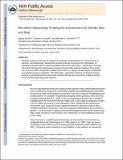Microbial Telesensing: Probing the Environment for Friends, Foes, and Food

View/
Published Version
https://doi.org/10.1016/j.chom.2009.07.004Metadata
Show full item recordCitation
Roux A, Payne SM, Gilmore MS. 2009. Microbial telesensing: probing the environment for friends, foes, and food. Cell Host Microbe. 6, no. 2: 115-24. doi: 10.1016/j.chom.2009.07.004.Abstract
Bacterial sensing circuits may be triggered by molecules originating from the environment (e.g., nutrients, chemoattractants). Bacteria also actively probe the environment for information, by releasing molecular probes to measure conditions beyond the cell surface -- telesensing. Perceiving the environment beyond is achieved by sensing environmentally induced changes in those probes, such as occurs when a siderophore chelates an iron atom, or a quorum sensing signal is inactivated by a specific enzyme or adsorbent. This information, captured by chemical and physical changes induced in specifically produced molecules transiting through the environment, enable bacteria to mount a contextually appropriate response.Other Sources
https://www.ncbi.nlm.nih.gov/pmc/articles/PMC2766869/Terms of Use
This article is made available under the terms and conditions applicable to Other Posted Material, as set forth at http://nrs.harvard.edu/urn-3:HUL.InstRepos:dash.current.terms-of-use#LAACitable link to this page
http://nrs.harvard.edu/urn-3:HUL.InstRepos:33867372
Collections
- HMS Scholarly Articles [17921]
Contact administrator regarding this item (to report mistakes or request changes)


